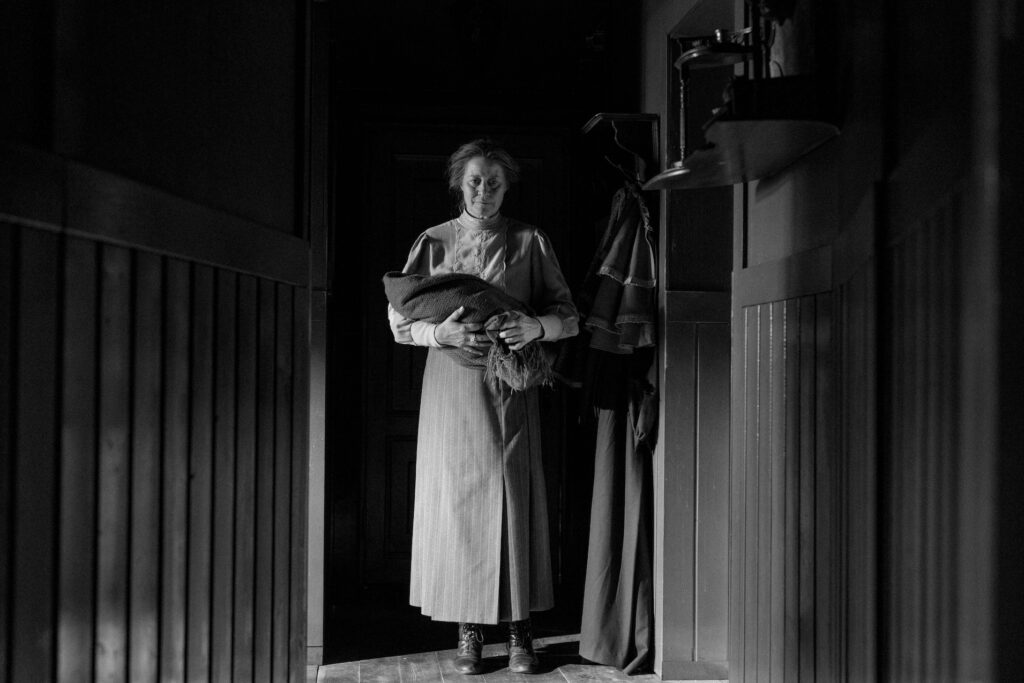As Beautiful as It Is Disturbing, ‘The Girl With the Needle’ Is Likely To Haunt Viewers Long After They Leave Theaters
Here is a film freighted by moral choices and psychological turns that most of us could barely acknowledge, let alone entertain. Movie-goers seeking a light night out at the pictures should think twice.

Along with being among the most beautiful of films, Magnus von Horn’s “The Girl With the Needle” is among the most disturbing. Its visual allure can be attributed, in significant part, to cinematographer Michel Dymek.
Working in crystalline black-and-white, Mr. Dymek brings a sometimes operatic and invariably pensive range of values and textures to the proceedings at hand. Painters like Rembrandt, Vilhelm Hammershoi, and Francis Bacon are brought to mind, as are filmmakers such as F.W. Murnau, David Lynch, and Béla Tarr. It’s a ravishing movie.
“The Girl With the Needle” is, as befits any creditable film, more than the sum of its visuals, though “ravishing” isn’t the word for the tale it tells, not in the least. The screenplay by Mr. Von Horn and Line Langebek takes us into territory that is in line with storytellers like Thomas Hardy, Anton Chekhov, and Thomas Mann. Here is a film freighted by moral choices and psychological turns that most of us could barely acknowledge, let alone entertain. Movie-goers seeking a light night out at the pictures should think twice.
“The Girl With the Needle” is Denmark’s entry for the Best International Feature at next year’s Oscars, and has already racked up considerable notice across the Atlantic and up north. The European Film Awards bestowed honors upon Jagna Dobesz’s sterling production design and Frederikke Hoffmeier’s understated, if sometimes clattery, musical score. The juries at Cannes and the Toronto International Film Festival singled out the movie.

What the Academy of Motion Picture Arts & Sciences will make of Mr. Von Horn’s film will be interesting to see. This is especially the case if its members watch “The Girl With the Needle” in conjunction with a film screened at the 2024 Greek Film Expo, Eva Nathena’s “Murderess” (2023), Greece’s submission for Best International Feature. The narrative and thematic commonalities between the two pictures are striking.
So striking, in fact, that conspiracy-minded cineastes might wonder if there are greater forces, if not outright plagiarism, at work. Still, let’s be honest: There are political and cultural exigencies that have helped shape the tensions at the center of each picture. Although neither “The Girl With the Needle” nor “The Murderess” takes place in the present, they are decidedly rooted in the here-and-now.
To what extent a critic should divulge their commonalities is a good question, particularly as Mr. Von Horn’s picture unfolds with a forbearance that would be upended if its trajectory were made plain. The air of ominousness the filmmaker establishes and the elegance by which it is maintained lead to places that have the portent of a Grimm’s fairy tale — that is to say, events occur that leave no one unscathed and only a handful of participants wiser.
At the center of the film is 20-something Karoline (Vic Carmen Sonne, alternately gorgeous and bestial), a worker in a clothing factory that provides uniforms for the military. When an armistice is signed and the first world war comes to an end, she finds herself at the mercy of societal pressures, callow men, and what looks to be a perpetual slog through poverty.
When Karoline becomes pregnant, she goes to drastic measures to abort but is prevented from doing so by Dagmar (Trine Dyrholm). The older woman convinces Karoline to bear the child and have it placed in the care of a rich family. Dagmar uses the family business, a sweet shop, as a front for an illegal trade in children born out of wedlock.
When Karoline begins working at the store as a means of paying off her debts, she becomes increasingly aware of furtive goings-on and is tasked with uncomfortable responsibilities, one of which involves Dagmar’s young daughter, Erena (Avo Knox Martin). Life gets more complicated when Karoline’s husband Peter (Basir Zeceri) returns from the front, deeply troubled and horribly disfigured. At which point, Mr. Von Horn takes his protagonists through byways that are no less engaging for their ironies, cruelties, and sporadic kindnesses.
Mr. Van Horn has created a dreamscape that will haunt viewers long after the theater lights have been turned up. “The Girl With the Needle” is one of the best films of this troubled year.

